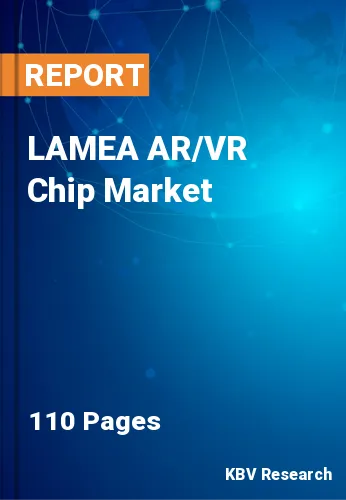The Latin America, Middle East and Africa AR/VR Chip Market would witness market growth of 28.5% CAGR during the forecast period (2022-2028).
Simulation-based virtual reality is one way to make virtual reality a reality. Driving simulators, for instance, give the driver the appearance that they are operating a real car by anticipating the motion of the vehicle due to the user's input and providing the driver with the appropriate visual, motion, and aural cues. People can participate in the virtual environment using both a real video feed and an avatar with avatar image-based virtual reality.
The 3D distributed virtual environment allows for participation using either a traditional avatar or a real video. Depending on the capabilities of the system, users can choose their form of participation. Many virtual reality applications, like robot navigation, building modeling, and aircraft simulation, depend on accurate representations of the real world in projector-based virtual reality.
In the computer graphics and computer vision communities, image-based virtual reality systems are becoming more and more common. Accurately registering the 3D data that has been gathered is crucial for producing realistic models; often, a camera is used to represent small objects that are close up. With desktop-based virtual reality, a 3D virtual environment is displayed on a standard desktop screen without the aid of any specialized VR positional tracking apparatus.
Activision established dedicated Call of Duty servers in Riyadh and Jeddah in association with the Saudi Telecom Company. Furthermore, in October 2020, the developers of the video game Valorant, Riot Games, who also created League of Legends, followed suit with Middle Eastern servers. The International Esports Federation (IESF) signed an MoU with the Motivate Media Group of the UAE as part of their efforts to expand Esports in the Middle East, and Dubai intends to build a specific Esports stadium as part of this expansion.
The Brazil market dominated the LAMEA AR/VR Chip Market by Country in 2021, and would continue to be a dominant market till 2028; thereby, achieving a market value of $122.9 Million by 2028.The Argentina market is experiencing a CAGR of 29.2% during (2022 - 2028). Additionally, The UAE market would display a CAGR of 28.2% during (2022 - 2028).
Based on Device Type, the market is segmented into Head Mounted Display, Gesture Tracking Device, Projector & Display Wall, Head Up Display and Handheld Device. Based on End User, the market is segmented into Gaming, Entertainment & Media, Aerospace & Defense, Healthcare and Others. Based on Chip Type, the market is segmented into Processor ICs, User Interface ICs and Power Management IC. Based on countries, the market is segmented into Brazil, Argentina, UAE, Saudi Arabia, South Africa, Nigeria, and Rest of LAMEA.
Free Valuable Insights: The Global AR/VR Chip Market is Predict to reach $7.6 Billion by 2028, at a CAGR of 25.4%
The market research report covers the analysis of key stake holders of the market. Key companies profiled in the report include IBM Corporation, NVIDIA Corporation, Intel Corporation, Samsung Electronics Co., Ltd. (Samsung Group), QUALCOMM Incorporated (Qualcomm Technologies, Inc.), Spectra7 Microsystems Inc., MediaTek, Inc., Huawei Technologies Co., Ltd. (Huawei Investment & Holding Co., Ltd.), Advanced Micro Devices, Inc., and Imagination Technologies Limited.
By Device Type
By End User
By Chip Type
By Country
Our team of dedicated experts can provide you with attractive expansion opportunities for your business.

